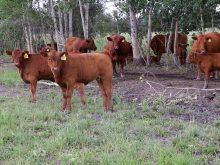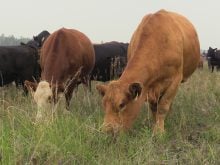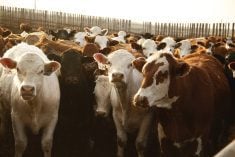Producers who haul cattle out of province will need to upgrade their training and licence by March 15
Producers who haul cattle to out-of-province feedlots or slaughter plants will have to follow new drivers’ licensing rules once they take effect in Saskatchewan March 15.
Although farmers are exempt from the mandatory training to obtain a Class 1A licence, and can get an F endorsement on their Class 5 licences if they intend to haul within the province, SGI director of carrier and vehicle standards services Ron Foord reminded cattle producers to consider how the new regulations will affect them.
Speaking at the Saskatchewan Stock Growers Association semi-annual meeting last month, Foord said farmers who live near provincial borders or who already haul cattle to feedlots in other provinces can upgrade their licences now or will have to take the mandatory entry level training when it becomes the law.
Read Also

Feeder market continues the climb
For the week ending Aug. 30, Western Canadian feeder cattle markets traded $4-8 per hundredweight higher on average.
The decision depends on where someone is hauling, he said.
“If you’re hauling grain to the local terminal, (the F endorsement) might work for you, but if you’re on the border” it may not be enough, he said.
Since the change doesn’t take effect until March 15, farmers could still write their learner’s licence tests, take the existing course at a school and get their 1A licences.
After that, the 20-day course will cost between $8,500 and $10,000.
The SSGA membership received an overview of the 11 modules in the course and the time allocated to each segment of training.
Some thought the course time was too long, while others asked why a skills assessment and test challenge couldn’t be done.
Foord said a driver could be technically capable but still not aware of things like changing road conditions and the kinetic energy of the vehicle. The course is designed to teach drivers about all aspects, he said.
Specific training for things like hauling cattle or large loads of liquids will be left up to the employers once a driver has passed the entry level training.
Former SSGA president Doug Gillespie said quality training doesn’t happen overnight and he applauded the idea of mandatory training.
“I think it needs to be looked at as a step forward in the safety of the roads,” he told the meeting.
Another member noted that Class 5 drivers who tow large recreational vehicles are a safety hazard.
Linda Johnson of SGI said there is a special licence available and driving schools do offer the training, but only a few take it.
Foord added that many farmers are already towing more than they might think.
“If you’re in the farming industry and you’ve got a two axle truck, you can go up to 13,000 kilograms, and if you have an 11 foot pintle hitch, you can haul a tandem axle trailer, which roughly puts you at the same weight as a semi trailer, with a Class 5 licence,” he said.
“So theoretically, today in the farming community you can take your son or daughter out of high school and stick them in a vehicle carrying the weight of a semi load. That is happening today.”
Farmers who intend to obtain their F endorsement have to pass all the Class 1 written and road tests and submit a medical report. They have to be at least 18 and not novice drivers.
Federal Transport Minister Marc Garneau recently announced that a national mandatory entry-level training course for all semi-truck drivers will be in place by next January. It’s not yet known how farmers will be affected by that decision.
Right now, only Ontario, Saskatchewan and Alberta have implemented or will soon implement training.
















